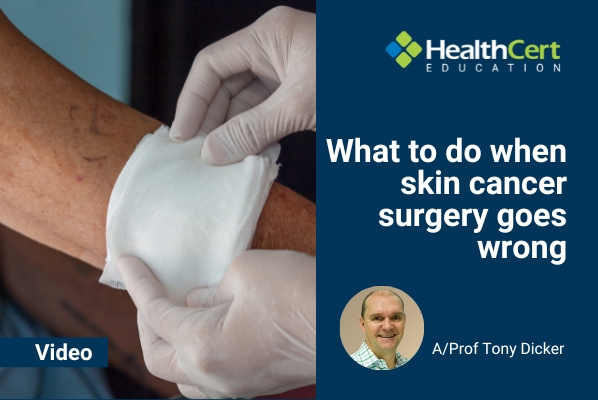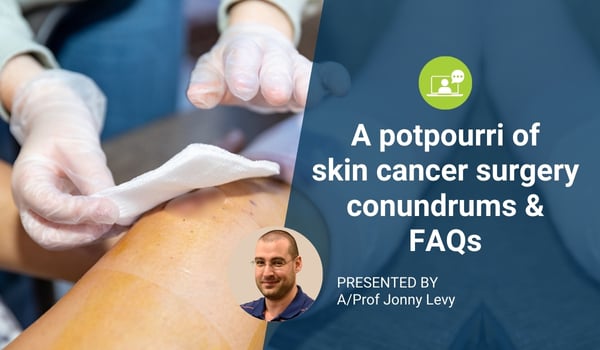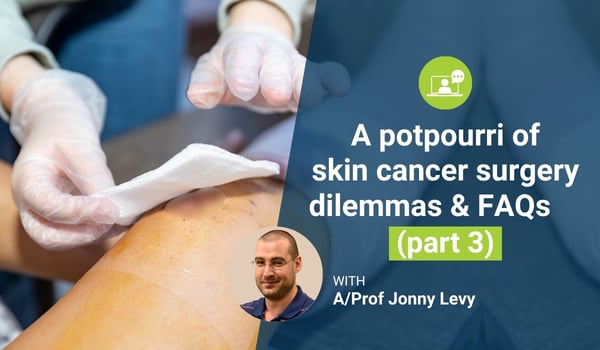Skin cancer case challenge: What would you cut?
Your surgical skills. One lesion. Your chance to win a free Surgery Masterclass seat.
.jpg)
HealthCert Education
We invite you to take part in this case challenge moderated by A/Prof Tony Dicker. Consider the real-life scenario below, then submit your surgical management plan — including your closure drawing — for a chance to be featured and win a free seat at the 2025 Surgery Masterclass in Brisbane.
Your task
Answer the 3 questions below.
Email your name, answers, and drawing to marketing@healthcert.com by Monday 30 June 2025.
Submissions will be published on this blog and discussed at the 2025 Surgery Masterclass.
The winner of the free Masterclass seat (or refund) will be announced 1 July.
The case
The patient:
- A 56-year-old female.
- History of previous BCCs on her cheek and forehead.
- No problems encountered during previous surgery on the face.
- Well, no medications, no blood thinning herbs or vitamins.
The patient presents with this lesion on the ala:
The diagnosis:
 This exercise is about management rather than diagnosis. Assume the lesion is a nodular BCC (or, if you prefer to biopsy the lesion, then assume the pathology report shows nodular BCC).
This exercise is about management rather than diagnosis. Assume the lesion is a nodular BCC (or, if you prefer to biopsy the lesion, then assume the pathology report shows nodular BCC).
The management plan:
In describing your approach for managing this BCC on the ala, please answer the following three questions.
Question 1: Is there any other information or images that you wish to capture that would be significant for this patient's care?
Question 2: Are there any non-surgical managements you might consider suitable for this lesion, and would you consider any of these options to be a better treatment than surgery?
Question 3: Assume the patient has agreed to a surgical management of this lesion. What is you preferred type of closure for this lesion?
Please save/download the below image and draw your answer.

Thank you for participating in this challenge!
The Surgery Masterclass
Eligible submissions will go in the draw to receive a complimentary place at the Surgery Masterclass (upcoming on 15-16 August 2025 in Brisbane), led by A/Prof Tony Dicker and Dr Tony Azzi. (If you have already registered, we will refund your full fee!) Click here to learn more about the Masterclass.
Your colleagues' responses
Dr Hoang Le
1: Medical history - Age, general health, nutrition. Current medications - blood thinners, diet. Compliance. Cost.
2: Cryo, Chemotherapy (Efudix/ Aldara), Curette and diathermy only if the patient is not suitable for surgery (but high risk of recurrence, need to explain to the patient) for example: Doctor skills, facility, general health, nutrition, blood thinners which would affect wound healing. Otherwise, WLE Surgery will be the best option for nodular BCC.
3: Can do ellipse, advancement or modified rhomboid as per photos. However, excision (Mohs Micrographic Surgery if possible) and grafting would be the best cosmetic choice for her. Donor graft could be taken from the base of the neck. Dressing intact for 5 days then graft take to check. Need to inform regarding the senseless grafting site. This method is preferrable given it can be repeated if the tumor is not clear from previous excision (no Mohs) and grafting. With a margin of 4-6mm. My preferable approach will be Modified Rhomboid (in first photo). If not clear, will consider excision and grafting.





Dr Mostafa Ziabari
1. Any info RE perineural invasion in the biopsy report to consider wider margin?
2. Metvix PDT, Rhenium-SCT (skin cancer therapy) and radiotherapy. I believe surgical treatment is considered superior compared to these options.
3. My preferred surgical solution: FTSG (pic 1), Shark island pedicle advancement flap (pic 2) and transposition flap (pic 3).



Dr Srikumaran Shan
1: I would like to know the size of the lesion (defect would be less than 6mm or over 6mm) which is important to decide about management of the surgical excision. In addition, I would like to check the forehead (glabellar area and pre auricular area) for any previous scar (in case if a skin graft involves for a donor site).
2: If the size of the defect is smaller than (less than 6mm) secondary intention of healing is suitable for this location. I wouldn't recommend any curettage and cautery for this location.
3: I have two surgical options for the closure. Option 1- Full thickness skin graft (donor site, glabellar or pre auricular area). Option 2- Bilobed flap. Advantage of flap- one wound site to manage compared to graft flap healing better, no mismatch skin colour. I will give advantages and disadvantages to the patient regarding both options and involve patient in the decision making.

Dr Seyedeh Maryam Sahafi
1: I look at full face picture from front, where was previous lesion on cheek, same side, how is the scar - to understand the nature of skin reaction. Any previous cosmetic treatment in the area, feeling skin mobility, expectation of patient about the procedure and outcome.
2: High risk area , chance of recurrence, looks more than 6mm diameter nodular BCC, not suitable to Aldara, age as well another reason not choose it. PDT may be helpful not in the area, ellipse will distort the nasolabial fold -- will not do it. graft can be considered as recommended by ladder with periauricular area, considering mobility of skin in the area ,or supra clavicular.
3: Considering flap, advancement, bilobed, if the mobility of skin be suitable. I am not confident to do it at the moment.

Dr Hooi inn Neoh-Solman
1. Patient’s lifestyle and surgical preference.
2. I will discuss with patient other options to treat this area. But I would not recommend other options - chemotherapy, radiotherapy because of her age and location of the lesion. Will recommend Mohs surgery to excise this area.
3. Mohs surgery can minimise tissue loss, my preference is healing by secondary intention if the defect is small. The scar will looks better and colour match too. If patient choose not to go ahead with the option or the defect is bigger and deeper, island pedicle flap will be my option close this defect (from the photo, should have sufficient tissue and movement to close the defect).

Dr Peter Morero
1. Previous surgery on the nose or FTG sites, medical comorbidities, smoker?, home environment and ability to manage.
2. Imiquimod is an option with recurrence rates less than 2 % according to a systematic review from 2020 (https://pubmed.ncbi.nlm.nih.gov/32527151/). 5FU not indicated for nodular BCC. Radiotherapy an option but potentially scarring. I wouldn’t see the point of curettage/diathermy - likely the worst possible cosmetic outcome.
3. I would want to keep the alar crease as far away from any involvement as this could have an effect of the final cosmesis. Bilobed flaps have always worked quite well for me on the nose so this would be my preferred approach with the flap rotating medial to lateral. FTG from glabellar a reasonable alternative but I would prefer the flap.

Dr Prashanta Kumar Mitra
1. I think enough information has been given.
2. The patient has been previously operated for BCCs on her face , Such patients have tendencies to respond to surgical management . Moreover cryo, curettage, application of Aldara or Efudix etc has disadvantage of incomplete removal, ugly scarring ,recurrences etc. Moreover you never know that you have removed the lesion completely or not. I will explain the patient that excision is the only answer .
3. I have developed a complete new approach to such patient and this has come through my long experience of coming across chances of incomplete excisions ,perineural invasion on histology and subjecting the patient re-excisions etc .I will explain the patient that I shall excise the lesion under local anaesthesia with 4 mm of margin around the visible cancer area and deep to the cartilage. I will use the electrocautery and/or running sutures with 5/0 monosyn to achieve the haemostasis, Mark the specimen at 12'0çlock send the specimen for histopathology. I will wait for the microscopic report. Depending upon the report my further action will be as follows: a) If the excision is complete I will do the second stage full thickness skin graft to close the wound; b) If the histology result suggests that that it is very close to or incompletely excised at particular area such as 3'0çlock or 6 or 9 '0' clock then I will excise more and do the skin graft. Advantage of my approach: I practice in rural area where the patients can not afford the time, travelling, or finance to seek the skin specialist surgeons who are located in the metropolitan cities. This is a time saving, money saving alternative to MOH'S surgery.


Dr Heather Lawson
1. I would definitely do a punch biopsy, for diagnosis, depth and PNI elimination.
2. Imiquimod 5% has at least a 70% clinical and historical clearance according to studies, so this is a consideration. It may leave an unsightly scar and wouldn’t be my first choice in a woman of only 56.
3. There are a number of surgical options available for this lady. She may well be very concerned about scarring and prefer to see a plastic surgeon, or she may not. The lesion is on the lateral alar, which precludes side to side closure or an island pedicle flap. Bilobed flap is an option but will give more scar lines on the nose and is an option I was once discouraged from using by a plastic surgeon!
FTSG is a good option (from a preauricular donor site, if available) but there is always a risk that it will leave a white scar. The lesion isn’t big, and if it isn’t deep (as per my biopsy result), secondary intention healing can give a good cosmetic result on the alar. There are 3 flaps that I would consider using: a nasolabial transposition flap (picture 1), which gives a good skin match but can result in obscuring the alar groove; a shark island pedicle flap (picture 2), which can distort the alar noticeably, and I would be wary of using this in a woman concerned about cosmesis. Another flap that I’ve seen on the SCCA blog is a jigsaw flap (picture 3), which would probably give the best scar, although might obscure the alar groove.



Dr Prakash Pattnaik
1. Collect good Macroscopic and Dermoscopic images with her consent. Family history of prior NMSC. Detailed history of her prior BCC surgery and review their histology types. Any evidence from prior surgery of recurrences. Profession or hobbies that expose to increased UV radiation Exposure.
2. If the biopsy or dermoscopic diagnosis strongly points to Nodular BCC, then best is a good 3 -4 mm surgical margin and lesion Excision from Ala of Nose. However, option that could be trialed if the patient was unwilling for surgery or other high-risk issues or even cosmetic concerns would be: 1. Cryotherapy; 2. 5 FU (Efudix Topical apply treatment); 3. Imiquimod Therapy.
3. 1. Surgical Curette – With healing by Secondary intention.
2. Bilobed Flap – Rt Ala nose – Will provide good cosmetic outcomes as does not move out of the nasal sub units. Only Issue could be Pin cushion effect. (Drawing 1)
3. Shark Island Pedicle Flap – Maintains the Nasolabial Fold – good cosmetic outcome. Only Issue could be Pin cushion effect. Which can be easily managed with microneedling or dermabrasion. (Drawing 2)
4. Full Thickness Skin Graft (FTSG) - Donor Site from ipsilateral or Contralateral Pretragal area or retro auricular area. Ensures good colour match. We have to confirm the donor site is disease free prior to taking from donor site.(Drawing 3)



Dr Ashwin Suresh
1. I would like to see views of the woman's ala/nostrils from inferiorly to assist with planning the treatment.
2. For nodular BCC, the non surgical options to consider would be cryotherapy, photodynamic therapy and radiation therapy. I feel all of these options are inferior to surgery. Cryotherapy may cause hypopigmentation and has a higher recurrence rate. Photodynamic therapy has less evidence for treating nodular basal cell carcinomas.. Radiation therapy would be considered only if surgery was not an option, and has lots of side effects including radiation dermatitis and fatigue.
3. My preferred closure would be a bilobe flap as below (see attachment) - this would give a good skin match but care needs to be taken to avoid ectropion.

Dr Tandi Hobbs
1: Offer a referral to a Plastic surgeon or a Dermatologist trained in Mohs surgery. If the patient declines and agrees that she wants me to do the procedure, then I’d be happy to help her. PMH: Does she have conditions like Ehler-Danlos or is she on long-term corticosteroids etc., thus medical conditions that will impact healing and scarring. Other Images: It will be nice to see how the other scars have healed on her face (forehead and cheek). I will want to see how the skin looks in front and behind her ear and supraclavicular area with the purpose of harvesting skin from these areas for potential skin grafting.
2: Factors supporting standard surgical excision: (1) Location of lesion: The BCC is on the H-zone of the face. This is a higher risk for recurrence of BCC. (2) Size of lesion: The BCC is less than 2cm. The tumor looks well -defined and if the histology is accurate, nodular BCC’s usually are well-defined. It is a non-aggressive histology subtype - nodular BCC. It’s a primary tumor, not a recurrence. Non-surgical treatment should only be considered in FAVOURABLE sites. The H-zone on the face is a high-risk area for recurrence. Non-surgical: ** Curettage and Electrodesiccation: Recurrences from 5.7-18%. For low risk areas this is in H-zone thus not appropriate. ** Cryosurgery: No histology confirmation of tumor removal. Recurrences 3.5-16%. Surgery 8.2% vs curretage and cryosurgery 17.6% recurrence. INFERIOR cosmesis. ** Topical imiquimod: Imiquimod is not licenced for use on the NOSE, nor for nodular BCC. If tumor >0.4mm deep then 57.9% recur. Efficacy of nodular BCC relatively low. Excision with 4mm margin for n-BCC clearance 99% vs 83% Imiquimod used daily for 6 weeks. BUT this was in a low risk area. Typical imiquimod more for superficial BCC’s in low risk areas.** Flurouracil: This is contraindicated for nodular BCC’s. It’s an option for superficial BCC in low risk areas. ** PDT: No histology. Less effective for n-BCC’s due to penetration and 76% clearance at 5yr vs 96% with surgery. Good cosmesis but expensive and painful. This is for superficial BCC in low-risk sites.** Radiotherapy: Not appropriate as this is a small non-recurrent, low-risk lesion, albeit in a high risk area. 5yr cure rates 91-93% for primary BCC. More for patients ineligible for surgery. ** Hedgehog signalling pathway inhibitors: Patient is not immunosuppressed, lesion is not recurrent or poorly defined, no prior radiotherapy to lesion. Low risk lesion thus NOT appropriate. ** Surgical excision: More than 95% 5-year cure with 4-5mm margins. This is the BEST option. ** Mohs surgery: Primary excision has a 4.1% 5yr recurence rate vs 2.5% if Mohs used. (12% 10yr vs 4.4 % 10yr respectively). This is EXPENSIVE - and not readily available. More for recurrent lesions and higher risk BCC’s (infiltrating BCC’s, bigger size) but this one is in a high risk area.
3: Patient agrees to surgery done by me, which options for closure. This is where I can list some options, but my confidence and surgical skills are not yet there. Need to consider: Remove the cancer, preserve cosmesis, avoid nasal ala flare, minimising crossing cosmetic units, maintain function. (1) Healing by secondary intention. Circular removal with 3mm margin. This is not ideal as it will cause a contracture and cosmesis with be inferior. (2) Full thickness skin graft. I think this is perhaps for me at present the most achievable option. Skin taken from pre or post auricular or supraclaviclar (hence the further photography). I’ve seen skin also taken from the glabella (but I would want to stay away from more scars especially on the central face). The cosmesis for FTSG I think is inferior to primary closure as there is always a mismatch in skin colour and contour. (3) Transposition flap. (a) Bilobed flap. I have only done one and that was on a patient's ear. I think I prefer the medically based bilobed flap (drawing 1). I’m just unsure how well the skin will move.



Dr Rebecca Ford
1: Information and images. Further needed information: This image – Are the drawn in lines including or excluding the margin? Patient skin history: skin cancer history, previous failed/successful grafts, reason for failure and other treatments she has had surgical/nonsurgical and histology results. MRSA history, skin infections, current skin infections. Medications history: aspirin, dabigatran etc immunomodulators, smoker, etoh intake, medication incl OTC - vit E, fish oil, aspirin etc. Images: Other information I would like is to touch the patient's skin to assess laxity and movement and skin tension lines around her nose. Images of the other side of her face and her nose on the other side of her face, under side, and from above. I would like to see images of her natural facial skin tension lines to see her scrunch up her nose, smile and close her eyes tight to see how her skin moves. She has tight appearing skin.
2: Other non-surgical options - if it is a nodular BCC no. Had it been Bowens or superficial BCC - yes topical treatments would be preferrable. However Dermnet/William* (2017) advises that it can be used for low risk nodular BCC - therefore it is important to know patient history of previous BCC if any and histology on those lesions if they were "low risk". *Williams HC, Bath-Hextall F, Ozolins M, et al. Surgery versus 5% imiquimod for nodular and superficial basal cell carcinoma: 5-year results of the SINS randomized controlled trial. J Invest Dermatol. 2017;137(3):614–19. doi:10.1016/j.jid.2016.10.019
3: My preferred closure would be a spiral flap and change the angle of the flap according to the images of skin tension lines.

Dr Rachel Lee
1: I would want to know: On HISTORY: • Any previous surgery to nasal /right cheek area including skin flaps/ donor sites. • Is she a smoker. • Patient’s expectations/ lifestyle. • Cost burden to patient (if applicable). On EXAM: • Size of lesion. • Mobility /quality of surrounding tissue.
2: • Chemotherapy (Effudix) twice a day for 2 weeks or PDT. • Cryotherapy. • Radiotherapy. • Curettage + Electrodessication. • Surgery is the best treatment as it provides: 1) Definitive treatment; 2) histology as well as clearance confirmation; 3) better chance of clearance for a ‘higher risk’ lesion on the H zone of the face where risk of recurrence is higher; 4) if reconstruction is planned and done well, better cosmeses than some of the options above; 5) most practical option for patient, saving time/cost especially considering requirement for ongoing monitoring due to risk of recurrence with some of the options above. **if surgery is combined with MOHs this will result in lower risk of recurrence; however this is not strictly necessary, as an adequate margin can be easily taken (assuming this is a nodular BCC) and are good options for coverage of the resulting defect. • Effudix is not strictly indicated for nodular BCC (indicated for superficial BCC in low risk areas) and can result in significant inflammation and poor cosmoses; may need more than one treatment. • PDT - not really evidence for this, and may need more than one treatment. • Cryotherapy - not really suitable for(better for superficial BCC), need several treatments, cannot confirm if lesion is fully treated, may lead to scarring or hypopigmentation, high recurrence rate. • Radiotherapy - expensive, not really practical - this is a low risk lesion, RT better reserved for high-risk lesions to reduce recurrence. Also has other side effects, eg radiation dermatitis. • Curettage and electrodessication - unable to obtain histology with high risk of recurrence. May result in scarring/poorer cosmeses.
3: Preferred closure is a full thickness skin graft [DRAWING 1] (donor harvested from pre-auricular or neck area where skin colour match is good). If there are any unexpected histological findings requiring a further surgical procedure, the graft can be easily excised and additional margins taken accurately; and there are options of flap coverages from surrounding tissue which are still available. + Second option would be advancement flap [DRAWING 2] (can hide part of the incision line in the nasolabial fold); or bilobed flap (more incisions required, scarring may be more obvious). Potential option - healing by secondary intention - will result in poor scarring/cosmesis - we can do better with reconstruction!


Dr Sarah Jeffrey
1: I'd like to know the size of the lesion (the picture appears to demarcate the lesion without margins), thickness, perineural invasion. I'd also like to know if there has been previous surgery nearby (does not appear to be from pictures). I'd like to feel the skin laxity, see how it moves with facial expression and check for symmetry of jowls/ nasolabial fold depth.
2: Other options are available for nBCC (imiquimod, PDT, radiation therapy) but these have lower efficacy and this patient is relatively young and healthy so surgery is still the best option.
3: There are several closure options for the nasal ala, however this lady has quite a pronounced alar crease which could be tricky to avoid flattening with most options. A FTSG could work well though skin colour mismatch would affect cosmesis. Rhomboid or bilobe flaps are other options. The best option I think though would be a spiral flap to recreate the alar crease and keep the skin colour consistent.

Dr Saad Qamar
1: Relevant information already obtained: previous surgery on face encountered no problems, she is 'well', no medications or blood thinning herbs/vitamins. Other useful information: Other regions of previous surgery (is this a recurrence?), cosmetic or radiotherapy regions. Any recent topical treatments including steroids? Smoking status. Any allergies? Any new conditions since last facial surgery? Other images relevant would be front on images and some images of facial expression frowning, smiling, closing eyes, scrunching nose. Patient preference on treatment options would be relevant. Offering referral to local dermatologist (Mohs surgery) or plastic surgeon also needs to be discussed.
2: There are non surgical options including radiation therapy, PDT, cryotherapy, hedgehog pathway inhibitors if patient is absolutely not a candidate for surgery or radiotherapy. Not recommended and off label use: imiquimod and 5FU. Using studies from this article Guidelines for the management of basal cell carcinoma?
N.R. Telfer , G.B. Colver , C.A. Morton. British Journal of Dermatology, Volume 159, Issue 1, 1 July 2008 I would surmise the most reliable options for least chance of recurrence to be excision. I would not consider any other options better than surgery. But what the patient vs the doctor considers 'better' is somewhat different depending on values and preferences. Without knowing the personality of this patient I would imagine most well 56yo would opt for the most durable option (i.e. excision).
3: Well defined bcc 3 mm margin should suffice. My plan for this lesion would be a transposition flap. The type of flap I would plan is a 'banner' flap. This would allow me to use adjacent tissue which would be of similar skin and slide in into the defect. I would also make use of the nasolabial fold. (See images.) I would use an absorbable suture to adhere the flap to the defect bed and make sure edges are everted (with a vertical mattress sutures to achieve this).



Update
Thank you to everyone who participated in this challenge. At the 2025 Surgery Masterclass, we enjoyed a great discussion around this case, including some of your responses posted above. While there is no single "correct answer", this is how A/Prof Tony Dicker approached this case:
 Question 1: Is there any other information or images that you wish to capture that would be significant for this patients care?
Question 1: Is there any other information or images that you wish to capture that would be significant for this patients care?
- Check the symmetry and opening through the nostril pre surgery.
Question 2: Are there any non-surgical managements that you might consider suitable for this lesion?
- Radiotherapy
- Not suitable for Aldara
- Not suitable for curettage and cautery
- Not suitable for Aldara
Would you consider any of these option to be a better treatment than surgery?
- No
Question 3: What is you preferred type of closure for this lesion?


 1800 867 1390
1800 867 1390









